Summary
March 29 - April 1, 1864. Union troops in Arkadelphia.
The Route
▷ We previously began at Hot Spring County and Rockport, ending at Caddo Valley where US 67 joins with Arkansas 7, which is our starting point.
▷ US 67 at Arkansas 7, Caddo Valley ARTurn left (southward) onto US 67 for 550 feet. This point can also be reached by taking I-30 Exit 78 Caddo Valley.
▷ Diamond Lakes Regional Visitor Center, Caddo Valley ARA marker is located at the Diamond Lakes Regional Visitor Center. Continue on US 67 S for 0.5 mile, crossing the Caddo River.
▷ US 67 at Old Military Road, Clark County ARAlthough not part of this route, the Military Road leads westward, continuing across the center of the county into the hills in the western part of Clark County that borders the Little Missouri River. Steele proceeded with his army to Arkadelphia to await the arrival of Brigadier General John M. Thayer with his troops coming from Fort Smith.
▷ Old Military Road at US 67, Clark County ARContinue on US 67 South for 3.5 miles. In the Arkadelphia city limits, US 67 is also North 10th Street.
▷ Barkman House, US 67 at Henderson St, Arkadelphia AROn the left (east side) is the Barkman House. Continue on 10th Street/US 67 for 0.2 miles to the intersection of US 67 and Pine Street/Dr. M. L. King Jr.
▷ US67/10th Street at Pine Street, Arkadelphia ARContinue (southward) to follow US 67 a total of 0.8 miles southward along North 10th Street.
▷ US67/10th Street at Caddo Street, Arkadelphia ARTurn left (eastward) onto Caddo Street for 4 blocks.
▷ US 67/Caddo Street at North 6th Street, Arkadelphia ARTurn right (southward) onto South 6th Street. Travel 0.4 miles to Laurel Street.
▷ US67/S 6th Street at Laurel Street, Arkadelphia ARTurn left (westward) onto Laurel Street then right (southward) into the parking lot on the north side.
▷ Clark County Historical Museum and Amtrak station, Arkadelphia ARThis is the Clark County Historical Museum and Amtrak station. Exit on the south side.
▷ Exiting museum/station on Walnut Street, ArkadelphiaTurn right (westward) onto Walnut Street (do not cross the railroad tracks to east).
▷ Walnut Street at US67/South 6th Street, Arkadelphia ARTurn right (northward) onto South 6th Street/US67 to make your way back to Pine Street.
▷ US 67/S 6th Street at US 67/Caddo Street, Arkadelphia ARTurn left (westwward) onto Caddo Street.
▷ US 67/Caddo Street at US 67/North 10th Street, Arkadelphia ARTurn right (northward) onto North 10th Street.
▷ US 67/North 10th Street, ArkadelphiaTurn left (westward) onto Pine Street/Dr. M.L. King Jr. for about 2.1 miles, crossing I-30. Be in the left lane. This point can be reached by taking I-30 Exit 73 Arkadelphia.
▷ Pine Street at Arkansas 51S/26WJust west of I-30, use the left lane to turn left (westward) onto onto Arkansas 51 South/Arkansas 26 West. Travel about 9.5 miles toward Hollywood.
▷ Arkansas 26 at Arkansas 51 SBear right to stay on Arkansas 26 W toward Antoine for 4.8 miles.
▷ Arkansas 26 at Arkansas 53, Hollywood ARArrive in Hollywood at Arkansas 26/Arkansas 53.
▷ This brings us to the next point of interest, Hollywood and Terre Noire Creek.
Google Maps
Show my location on map
At the popup, you must allow your web brower (not us) to know your location.
Your location should update every 5 seconds.
This brings us to the next point of interest, Hollywood and Terre Noire Creek.
The Military Road and Confederate Manufacturing Markers
A Civil War Sesquicentennial marker is located at the Diamond Lakes Regional Visitor Center at 124 Valley St. in Caddo Valley, on the left (eastern) side of the highway. The two-sided marker outlines the roles of the Military Road and of Arkadelphia in the Confederate war effort.
The Military Road Marker
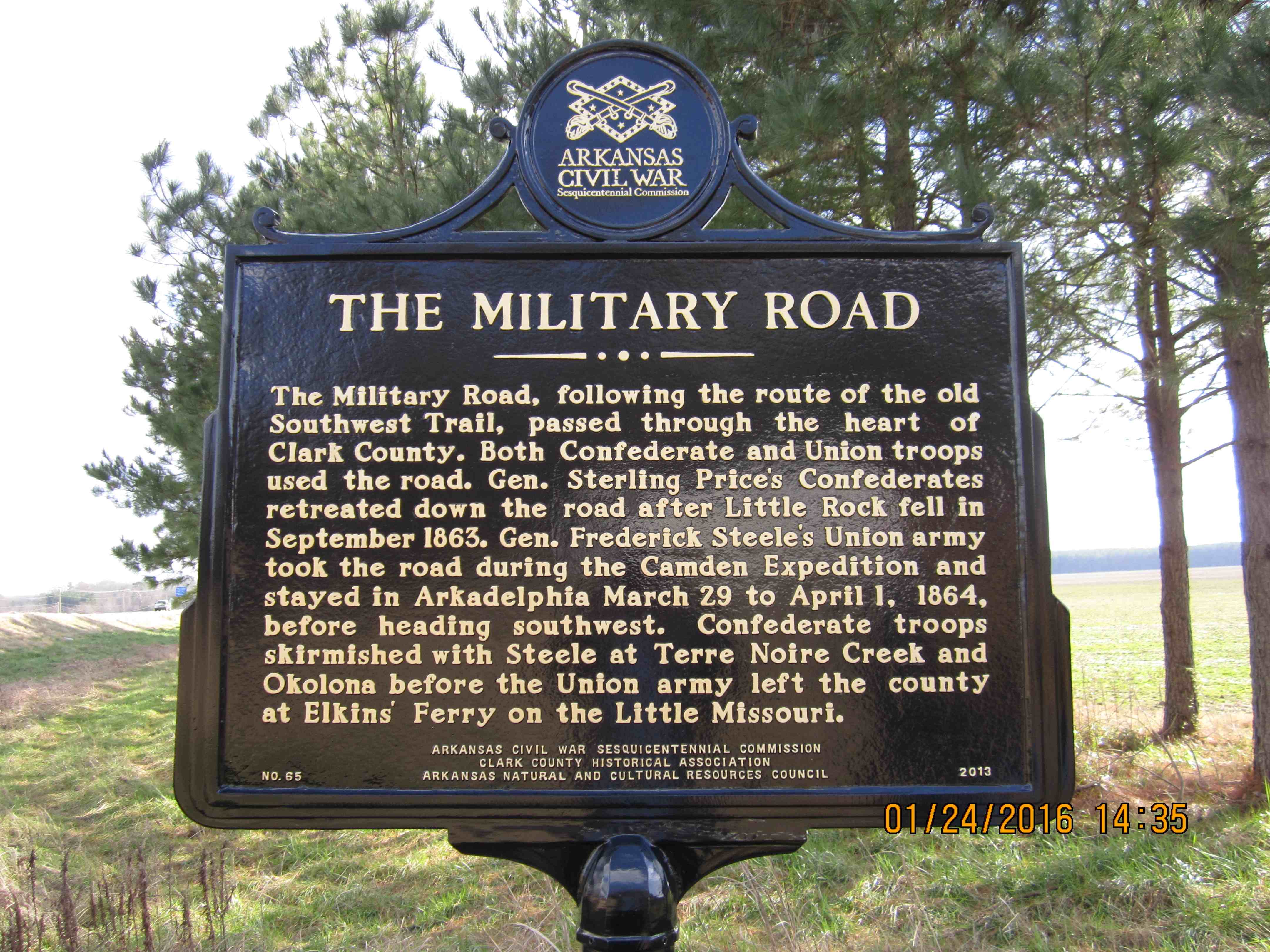
The Military Road, following the route of the old Southwest Trail, passed through the heart of Clark County. Both Confederate and Union troops used the road. Gen. Sterling Price's Confederates retreated down the road after Little Rock fell in September 1863. Gen. Frederick Steele's Union army took the road during the Camden Expedition and stayed in Arkadelphia March 29 to April 1, 1864, before heading southwest. Confederate troops skirmished with Steele at Terre Noire Creek and Okolona before the Union Army left the county at Elkins' Ferry on the Little Missouri.
Photo by Charles Todd
Confederate Manufacturing Marker
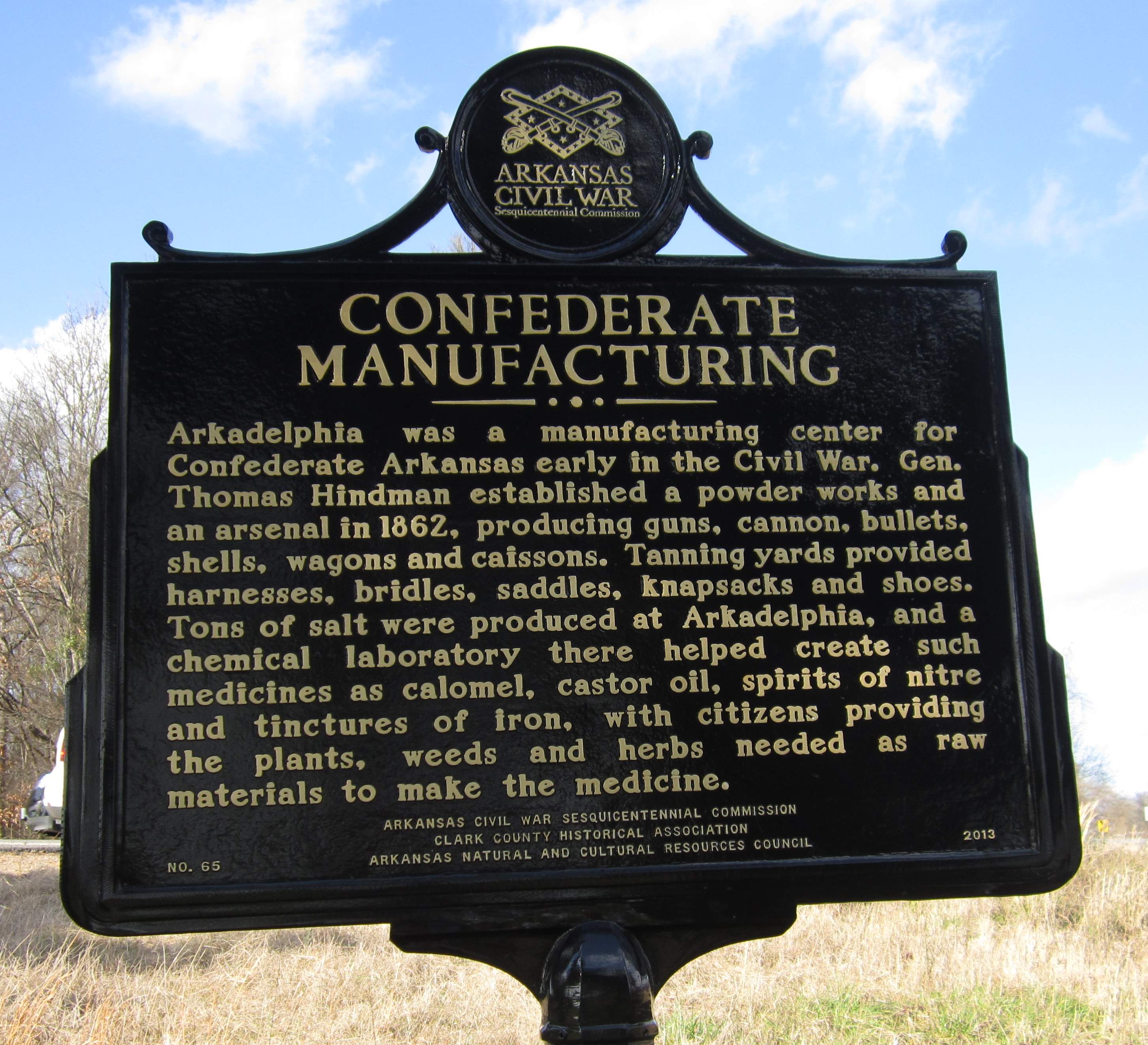
Arkadelphia was a manufacturing center for Confederate Arkansas early in the Civil War. Gen. Thomas Hindman established a powder works and an arsenal in 1862, producing guns, cannon, bullets, shells, wagons and caissons. Tanning yards provided harnesses, bridles, saddles, knapsacks and shoes. Tons of salt were produced at Arkadelphia, and a chemical laboratory there helped create such medicines as calomel, castor oil, spirits of nitre and tinctures of iron, with citizens providing the plants, weeds and herbs needed as raw materials to make the medicine.
Photo by Charles Todd
Barkman House
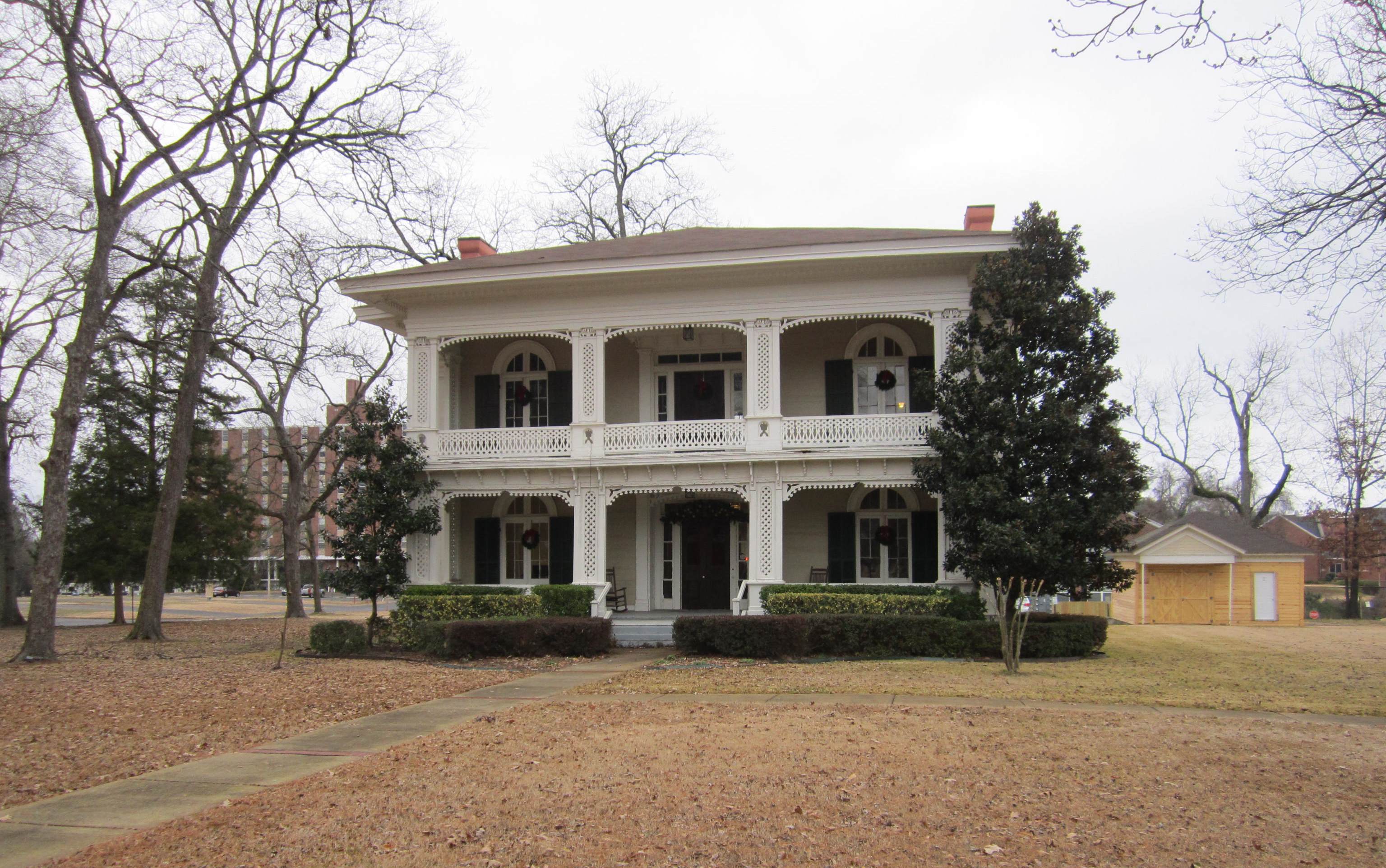
The handsome Barkman House, constructed about 1860, greeted the invading Union Army. James Barkman, the son of early settler Jacob Barkman, had built his home, a mix of Greek Revival and Gothic architecture, about 1860. Known as "The Father of Ouachita County", Jacob Barkman had settled on the Caddo River in 1811, established himself as a large planter and businessman and opened up shipping on the Ouachita River from Clark County to New Orleans. Today the Barkman House belongs to Henderson State University. The house was nominated to the National Register of Historic Places in 1974.
Photo by Charles Todd
Arkadelphia
Arkadelphia has been the county seat of Clark County since 1842. Originally known as Blakeleytown, it was a farming and trade center and had early schools. The Arkadelphia Institute, a school for boys and girls, opened in 1850. The Arkansas School for the Blind was established there in 1859. As the Civil War progressed, these schools closed. Soldiers of the invading Union Army ransacked the building of the Arkadelphia Institute during their brief stay in Arkadelphia. The Union Army left the city on April 1 when Thayer had not arrived from Fort Smith with his forces.
Clark County Historical Museum

The Clark County Historical Museum has exhibits on local history from prehistoric times to the present including the Camden Expedition. Founded in 2002 by the Clark County Historical Association, it is housed in the 1917 train depot. The depot is also an Amtrak stop.
Photo by Peggy Lloyd
Michael Bozeman House
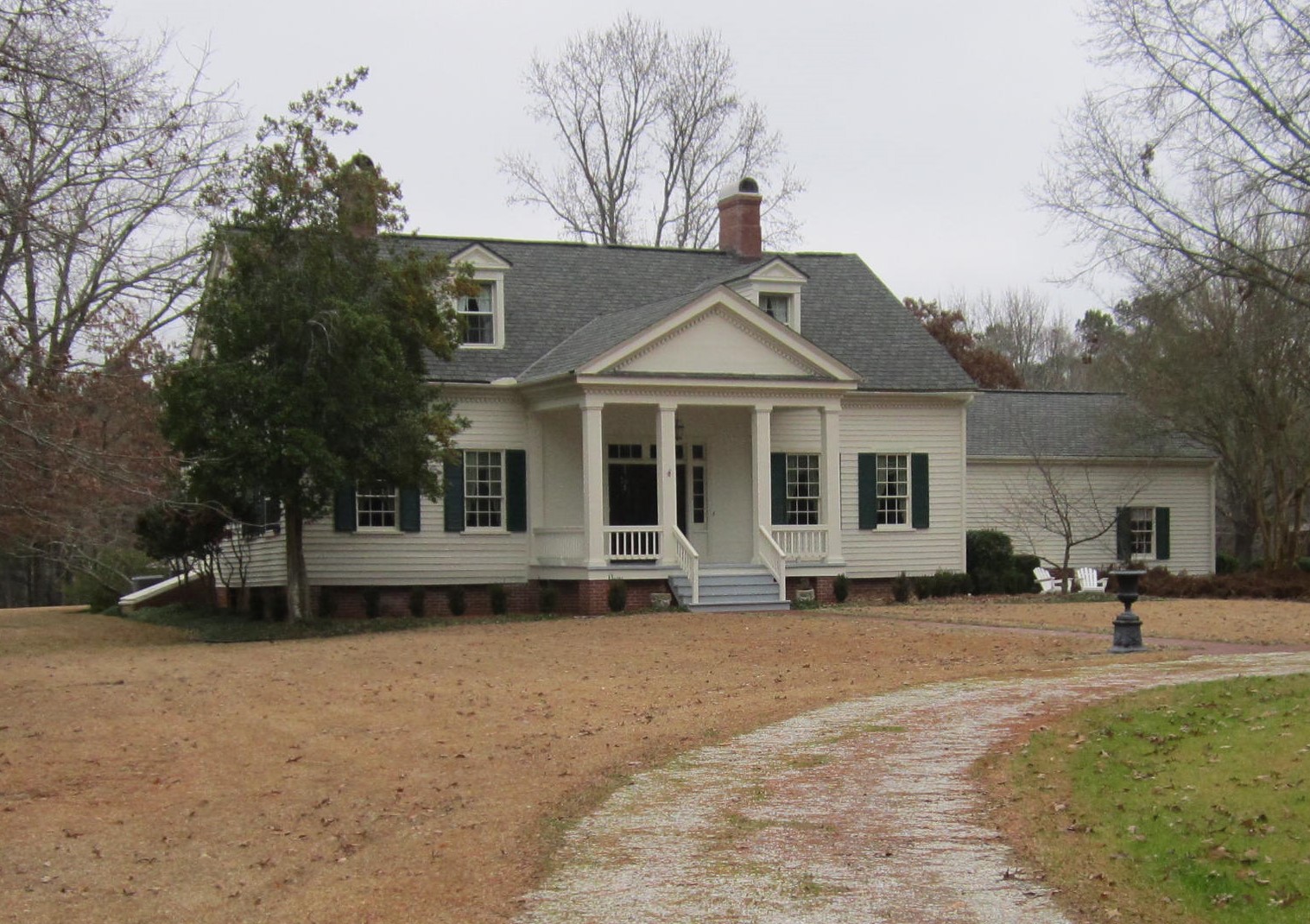
About three to four miles outside Arkadelphia is the Bozeman House, sitting on the right/north side of Highway 26. Michael Bozeman came to Arkansas in 1835 from Alabama, became a large landowner and producer of cotton, served in the Arkansas Senate and built this Greek Revival home about 1847. The Union Army passed near the home and skirmishes began near its site under the leadership of Brigadier General Joseph O. Shelby. Shelby is purported to have visited the Bozeman House before the fighting began. The house is on the National Register of Historic Places, and, after a period of vacancy, it is once again a private home.
Photo by Charles Todd
Shelby's Forces Attack Steele's Forces
Confederate General J. O. Shelby began a series of attacks on the advancing Union Army on April 1 shortly after General Steele's forces departed Arkadelphia. The purpose was to delay and harass the federals while Confederate forces ahead of the Union Army prepared for more serious engagements. Brigadier General Samuel Rice of the Union Army had the task of providing the rearguard for the advancing army in the skirmishing near Arkadelphia, and he did this successfully.
Hollywood
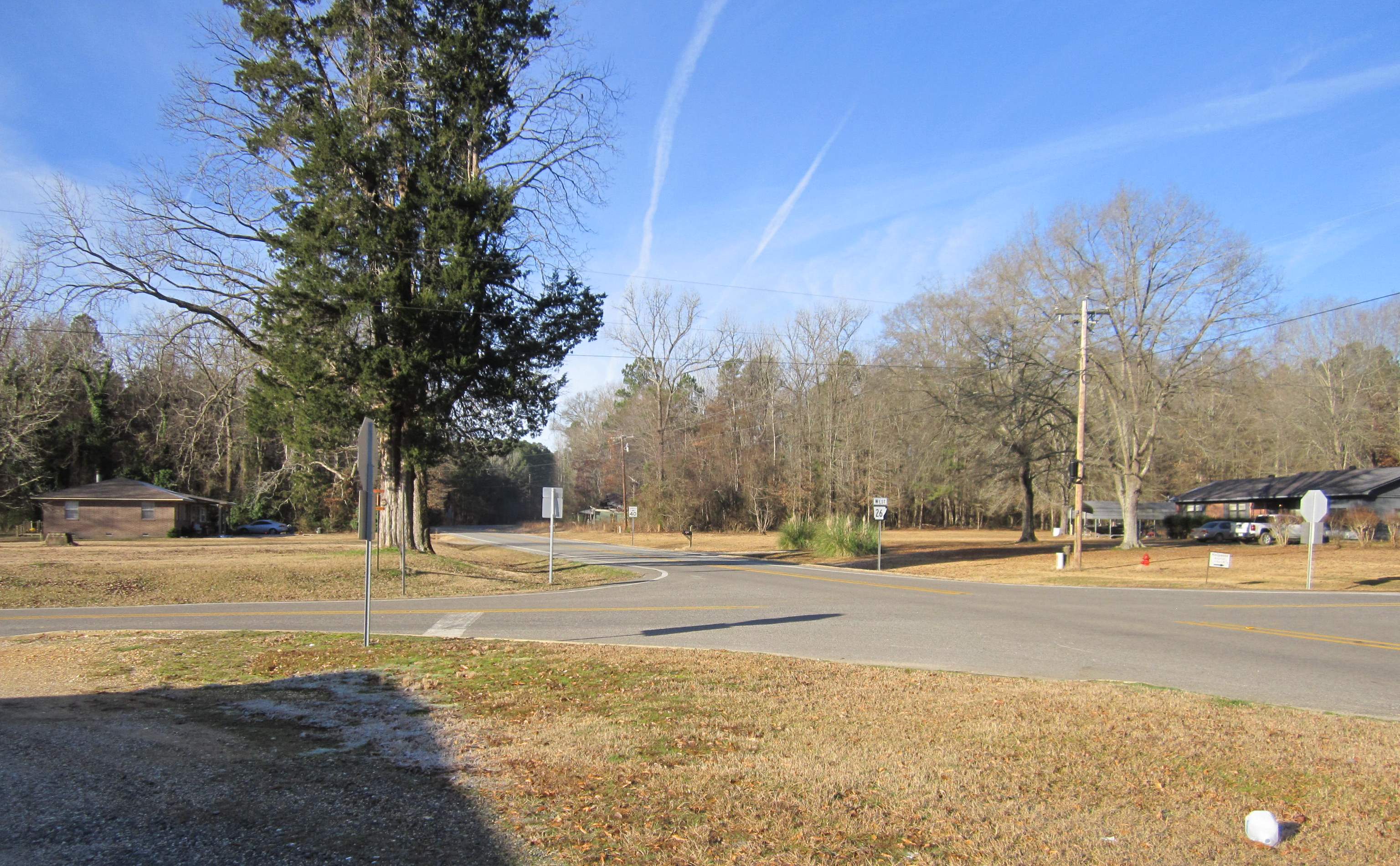
The Union Army passed through Hollywood on the Southwest Trail. Originally known as "Greenville", it served as the county seat of Clark County from 1830 to 1842 when county government moved to Arkadelphia. In 1860 it got a post office with the name of "Hollywood" because of all the holly trees in the area. The post office later moved and took the name 'Spoonville' but took the name 'Hollywood' again a few months later.
Photo by Charles Todd
Hollywood Methodist Church

The Methodist Church in the photo was in the area but not at the same location at the time of the Civil War. It now belongs to Clark County Historical Association.
Photo by Charles Todd
Up Next
This brings us to the next point of interest, Hollywood and Terre Noire Creek.


